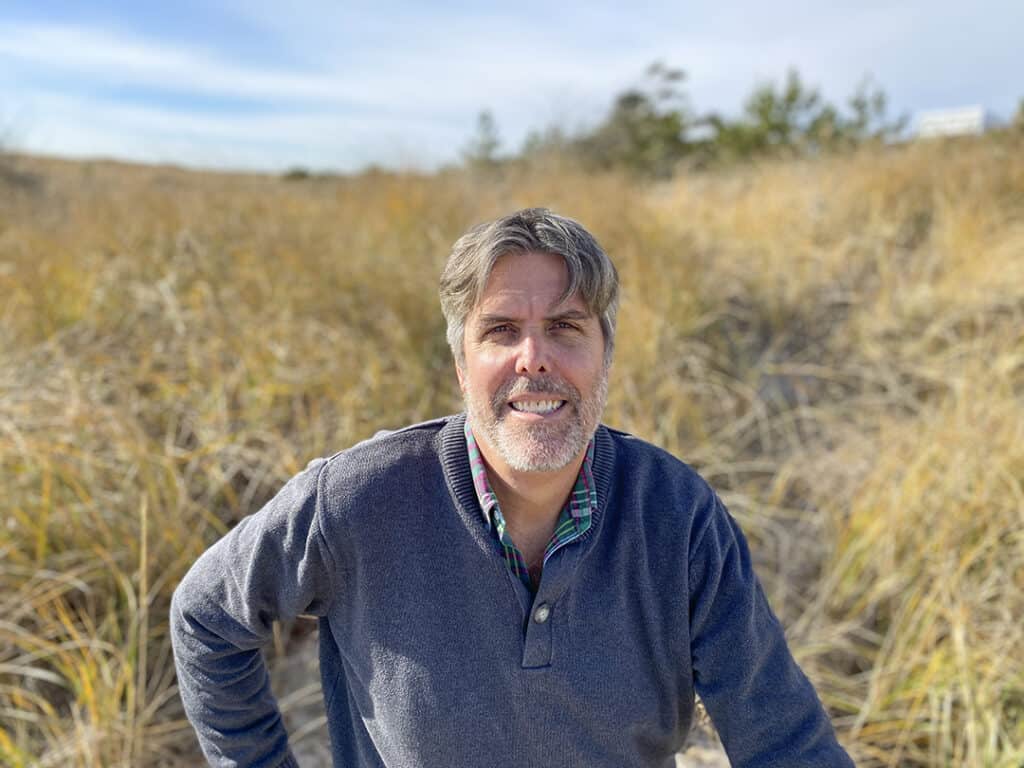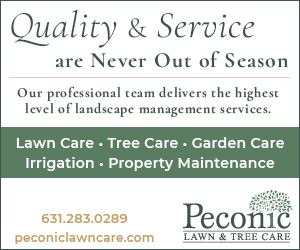Digging Deeper with Landscape Architect Brian Mahoney.

A Long Island native and landscape architect with more than 30 years in the field, Brian Mahoney knows the Hamptons from the ground up.
Even as a boy, he loved plants and flowers, he says. From fruits and vegetables to trees, bushes, and flowering plants, if it grew from the earth, Mahoney was interested. And though he had no idea that such a job as landscape architect existed, as Mahoney got older, he was encouraged to follow his passion.
“All the guidance counselors said, ‘You’re a horticulturalist. Go to Farmingdale.’ So I did,” he says of the two-year program close to his family’s home in Nassau County. “Before I knew it, I was in a landscape design class, and I was hooked.”
Mahoney, who also excelled at math — geometry in particular — then went on to earn degrees in landscape architecture and ornamental horticulture at Ohio State University. It’s one of the only programs in the country that housed landscape architecture in the college of engineering. “It was the perfect marriage of drawing and math,” he says.
Specializing in historic commissions and waterfront properties, Mahoney says that he particularly loves the opportunity to dig deeper into the history of a property whenever he can.
“I’m a sucker for an old house,” he laughs, adding that his Arts & Crafts home on the North Fork was the vision of architect Parker Hapgood. “It’s fun to learn the history of a place.”
One of the top coastal landscape architects working today, Mahoney marvels at the historical trajectory of his chosen profession. It came to the fore in the 1800s with Frederick Law Olmsted, widely considered to be the father of landscape architecture, but, remarkably, the field was still fairly new when he started practicing.
“There were only 1,381 other licenses issued before mine,” he recalls. “That’s pretty amazing when you think about it.”
The job encompasses much more than just the surface beauty or utility of a project, says Mahoney. It demands a deep understanding of dynamic ecosystems and vegetation, as well as current building materials and sanitary systems, plus keeping abreast of the myriad laws governing zoning, building envelopes, setbacks, wetlands, etc.
“There’s a lot more to landscape architecture than just watercolor images of landscapes,” he says. “What’s underground needs to be designed first. You’ve got to get the building envelope sorted out and know where everything can go before you can make everything pretty.”
Landscape architects here on the East End also need to take the demands of our harsh natural environment into account, as well as the specific lifestyle needs clients might have. A comprehensive property plan might include how to best incorporate a pool and accompanying equipment; accessory structures, such as pool house, guest house, barn or shed; and garage, or lack thereof, which necessitates outdoor storage areas for refuse and such.
There’s also the “garage-door syndrome,” Mahoney muses. “So many people go straight from the garage and into the house, and they completely overlook the fact that they have this beautiful front door and lawn that they aren’t using or even seeing,” he says. “It’s one of the most underappreciated parts of many properties. I encourage them to think about beautiful parking areas for everyday use.”
Speaking of the aesthetics of Hamptons style, over the past few years, Mahoney says that he’s noticed a distinct movement away from the traditional landscape and into a more native look. A growing number of clients, especially those who live in modern homes, want their personal spaces to include more indigenous plants.
“There will always be a place here for hydrangea, privet, green grass lawns and gravel, but I hear ‘I want a beachy look’ more and more,” he says.
Currently in-demand native species include nepeta, or catmint; lavender; ferns; and panicum, or switchgrass, says Mahoney. But, he warns, bringing a bit of the beach back to your property is not as simple as buying dune grass and just planting it anywhere. The soil and sun conditions are different for these types of plants, and they will need different care and understanding than other vegetation.
“These native species are built to endure in harsh environments, so they might not act the way you’d expect,” he says. “It’s best to have an understanding of that before you start digging.”
That said, there’s no reason to fear a landscaping project, says Mahoney. Even the simplest thing can improve one’s property for years to come. “The best time to plant a tree was yesterday,” he says.













![51 Mashomuck Drive presents an exquisite estate spanning 1.1± acres with 145± ft. of bulk-headed waterfront. The main residence, offering captivating vistas of Sag Harbor Bay and Shelter Island, encompasses 7,800± sq. ft. of living space, boasting 7 beds, 9.5 baths, and a media room/gym area. This turn-key retreat embodies opulence and comfort, inviting a life of unparalleled luxury. Represented by @cindyascholtz and @jvonhagn of @compass. [link in bio]](https://hamptonsrealestateshowcase.com/wp-content/uploads/sb-instagram-feed-images/466104990_18473128246030135_2802294086252776198_nfull.jpg)
![In a prime East Hampton Village location, 64 West End Avenue is surrounded by preserved land and offers complete privacy situated on the shores of Georgica Pond with breathtaking sunset views. With both ocean and pond views, residents can indulge in swimming and sunbathing at the waterside gunite pool. Represented by @marthagundersenluxurybroker and @paulbrennanrealestate of @douglaselliman. [link in bio]](https://hamptonsrealestateshowcase.com/wp-content/uploads/sb-instagram-feed-images/465766544_18472922440030135_758297788107249653_nfull.jpg)
![Enter into modern luxury at dreamy 26 Breezy Drive. This recently completed Sag Harbor new construction home on .59± acres offers 6 beds, 6.5 baths, blending elegance and style in every detail across 3 floors. Represented by @jfrangeskos of @thecorcorangroup. [link in bio]](https://hamptonsrealestateshowcase.com/wp-content/uploads/sb-instagram-feed-images/465771466_18472728874030135_3201710503931747819_nfull.jpg)

![Nothing says fall like a trip to Balsam Farms in Amagansett! 🍂 From fresh produce and homemade pies to all the autumn essentials, this is our one-stop shop for seasonal goodness. Who’s ready to fill their basket? 🥧🍎 [link in bio]](https://hamptonsrealestateshowcase.com/wp-content/uploads/sb-instagram-feed-images/465204442_533426036139100_7150688599976871296_nfull.jpg)
![Warm up this Fall Long Island Restaurant Week at Bistro Été, one of the coziest spots in the Hamptons! 🍷 Indulge in their $46, 3-course prix fixe dinner, perfect for savoring the season’s best flavors. [link in bio]](https://hamptonsrealestateshowcase.com/wp-content/uploads/sb-instagram-feed-images/465123294_584268867267597_7797422045545880538_nfull.jpg)

![This high-style 10,000± sq. ft. mansion by noted designer John Saladino with an inland barn guest house is set on a sweeping parcel of open farmland with 220± ft. direct oceanfront. It features a large waterside terrace with wisteria-shaded dining pergola, fireplace, heated pool, and private path to white sand beach. Represented by @fenewbold of @sothebysrealty. [link in bio]](https://hamptonsrealestateshowcase.com/wp-content/uploads/sb-instagram-feed-images/464971171_18471454396030135_496445565915170725_nfull.jpg)
